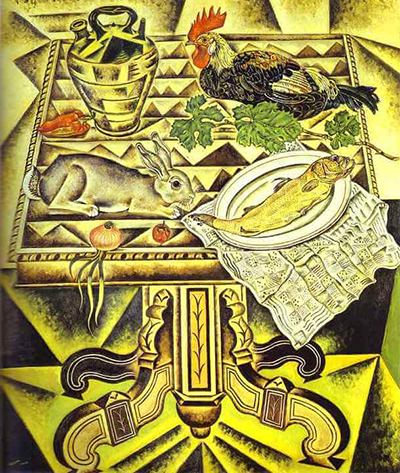Whilst many are familiar with abstract shapes and lines as found in famous paintings such as Bleu, Catalan Landscape and Constellations, they may not be aware of a series of still life paintings produced by Joan Miro over the period of several months in 1920.
The Table would be one of the best examples of that interesting body of work which showed a young artist experimenting with different artistic styles, trying to determine which he preferred. At the time he is known to have spent time in the company of a number of Cubist painters and so it was inevitable that he would try working in this manner himself. The likes of Picasso would, of course, subsequently move in alternative directions and leave their Cubist period, but others would actually stick with it successfully for the rest of their careers. Miro was very much in the former camp, though his achievements in this genre were still entirely impressive and worthy of note. The Table features content which is closely linked to the genre, that of a scene of a table within a room with various items laid across it. Miro produced several still life paintings of different items arranged across a table, but this one was perhaps the most memorable of all.
Cubism allows an artist to play with perspective and avoid the previously taught approaches that other painters would use. Miro makes this an interesting piece with the choices of content that he makes, which includes a chicken, a rabbit and also a fish upon a round plate. There is also a piece of newspaper, a ceramic jug and also some vegetables that presumably were to be used in the production of a meal for lunch or dinner. Miro allows almost half of the painting to be dedicated to an area below the table top, which was itself unusual - here we can examine a beautifully carved set of legs for the table, and also a vibrant carpet which provides another busy element to this complex piece. In terms of perspective, see how the rabbit appears to be flat, like a two dimensional drawing being placed into a three dimensional world. There is no doubt that the artist must have enjoyed working in this manner for a period of several months, and the work that he produced as a Cubist painter could rival the main members of the movement.
The overall movement was important in challenging what had gone before and offering an alternative. It would have many spin-off styles in which this use of perspective could be stretched in all manner of ways and this also encouraged other artists to challenge other art fundamentals in the years that followed. Miro himself would soon move on from this approach, but it was an important few months in his career as he continued to strive to find his favoured approach. Ultimately, that would come in the form of abstract shapes and lines that came around in the decades that followed, as well as the blocks of flat colour which we remember now as perhaps the true signature style of his latter years.




